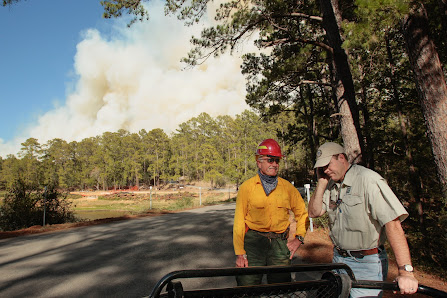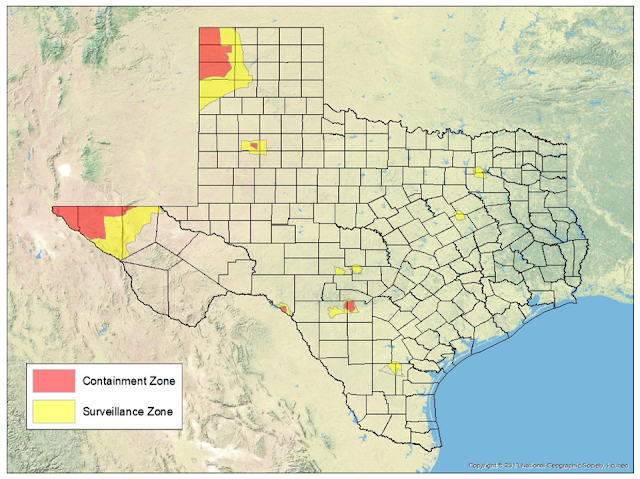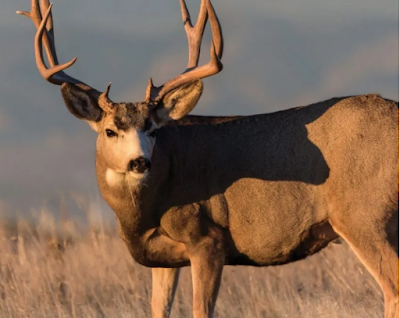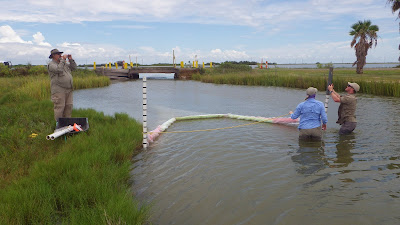Texas’ beloved protector of the outdoors moves on after leading TPWD for 15 years.
“Thank you for caring about our wild things and wild places. They need you more than ever.”
If any words can bring to life the Texas Parks and Wildlife Department mission, it’s this simple statement that Executive Director Carter Smith uses to close many speeches and writings. As the Yale-educated and conservation-steeped Texas native closes out his 15-year tenure, Smith’s legions of admirers always first mention his gift of gab.
Carter’s At Issue columns were a staple of Texas Parks & Wildlife magazine for years, thoughtful essays that conjured up his love for Texas with words that could serve well as lyrics for a future state anthem. He poured out his passion like glistening cream gravy over a chicken-fried steak. Pick any installment to find inspiration, like this gem he once penned about the Katy Prairie, in his typically ardent narrative style.
“What I saw back then was simply stunning: tens of thousands of ducks and geese congregating on remote roost ponds; giant kettles of hawks migrating through in the fall and spring; shorebirds and wading birds too numerous to count; vast flocks of sandhill cranes foraging on wheat and ryegrass fields; bald eagles perched around the rice fields and surrounding wetlands, consuming errant ducks and geese; bunches of grassland birds darting around the remnant prairies and a whole lot more.”
To lead the state’s “outdoors” agency in its many vital programs, Carter had to walk the walk, not just spout inspiring superlatives. Under his charismatic leadership, Texans enjoy the fruits of the agency’s programs to restore pronghorns and Guadalupe bass, the assurance of assistance during times of severe weather, new parklands to explore and so much more.
It’s not hard to see how Carter’s early life shaped him into a leader in Texas conservation. A seventh-generation Texas landowner who romped around native ranchlands with a family who prioritizes its love of the land, overhearing conversations with visiting conservationists like David Bamberger, hunting and fishing and exploring. He credits early daydreaming over the stories in Texas Parks & Wildlife magazine as a real inspiration. His grandmother started his subscription at age 8.
“I’d treasure the magazine when it would come in the mailbox — I’d just hoard it, not let anybody else in the family look at it,” he recalls. “I’d thumb through those amazing pictures and stories, and they would take me to some far corner of our state, some place that I wanted to go and see and explore and do.”
During his Yale days, Texas-fish-out-of-water Carter surreptitiously slipped issues of his favorite magazine into the shelves of the hallowed Ivy League library, secretly smiling when he saw it later in the hands of classmates.
Carter’s early professional years included an internship at TPWD and work at conservation non-profits, eventually landing his dream job as TPWD executive director at age 39. It didn’t take him long to win the hearts of colleagues who sensed his authentic passion and caring, smiling indulgently at his half-joking promises of “extra sunrises and sunsets” for bonuses, the payoff of heartfelt work.
“Working alongside Carter Smith for the last five years, I can say without reservation that he is one of the finest executive directors to ever run the Texas Parks and Wildlife Department,” says Texas Parks and Wildlife Commission Chairman Arch “Beaver” Aplin III. “He has stewarded the state and our resources with vision and integrity. In an agency full of incredible individuals, he has been an inspiring leader. There is no replacing Carter Smith.”
As Carter passes the torch to the next era of TPWD conservation leaders, let’s take a moment to see how the agency’s thrived during the challenges of the past 15 years under his leadership.
Crisis Response
Through wildfire and prolonged drought, public health crises and dramatic weather events, Smith has led game wardens, park staff and wildlife professionals in helping the state recover.
February of 2021 brought Winter Storm Uri’s power blackouts, wildlife kills, food/water shortages and a plethora of busted pipes at TPWD facilities. Dedicated staff protected facilities and counted wildlife fatalities despite the conditions, and subsequent measures helped affected species recover to pre-storm levels.
Three Texas Parks and Wildlife Department employees died in a helicopter crash on August 8, 2020, at Black Gap Wildlife Management Area while conducting aerial surveys for desert bighorn sheep. Carter’s was the voice of solace that soothed the pain and inspired the TPWD team to carry on the work of their fallen friends.
“I have always said that TPWD shines the brightest when times are the darkest,” he reminded grieving colleagues.
But perhaps no unforeseen emergency tested the agency more than the resulting destruction when Hurricane Harvey pointed its deadly eyewall at Port Aransas and Rockport in 2017. Game wardens were everywhere, rescuing people and pets, distributing hope and supplies, some continuing to work while their own families were displaced by the storm surge.
When emergency shelters overflowed, 62 Texas state parks opened their gates wide to offer a temporary home to evacuees for the month of September. Fees were waived for more than 8,000 displaced Texans, who enjoyed the beautiful scenery and helpful hospitality they found there.
“Hurricane Harvey forever changed the lives of many Texas Game Wardens and their TPWD family,” says Colonel Chad Jones, a new major with less than 6 months on the coast when the storm hit. “Carter rallied around me and Texas Game Wardens, standing tall and fast as a beacon to be followed throughout the storm. His mentorship and unwavering commitment to excellence throughout the devastating losses along the Texas Coast is a reminder of what leadership truly means. I hope to live up to that example every day.”
Wildlife Conservation
In a state where most land is privately owned, wildlife conservation depends on adroit land acquisition in Texas’ diverse ecoregions. Wildlife management areas like the recent Powderhorn Ranch, Yoakum Dunes and Roger Fawcett properties represent unique wildlife resources and opportunities, with endowments that support long-term conservation and management of public lands in Texas.
“Carter has always been supportive of sound science and research activities, which has led to better resource management across Texas,” says John Silovsky, Wildlife Division director.
Any success in natural resource management and stewardship also requires the enthusiastic participation of engaged people: Texas landowners, the agency’s many partner organizations and TPWD staff.
“Certainly, one of Carter’s most successful attributes that has advanced conservation in Texas is his ability to relate to all people,” Silovsky says. “Carter has a big heart — he’s always tried to take care of his staff and do his absolute best for the landowners of Texas.”
It took two legislative sessions’ worth of effort for TPWD to gain authorization to charge a fee for participation in the Managed Lands Deer Program. That may not sound like a big deal, but the resulting income funded 13 additional wildlife biologists to better address the technical guidance requests of landowners and wildlife enthusiasts across the state.
“With Carter’s leadership and persistence, this was one of the most impactful advancements of conservation delivery for the landowners of Texas,” Silovsky says.
All TPWD staff implementing the use of prescribed fire are now required to meet the standards of National Wildfire Coordinating Group qualification (training, experience and physical fitness). This new standard promoted inter-divisional cooperation on fire management efforts and facilitated a new level of cooperation with external partners such as the Texas A&M Forest Service and U.S. Fish & Wildlife Service.
“Carter has long recognized the important role of fire as a tool in managing Texas wildlife and their habitats, as well as its role in soil and water conservation.”
The percentage of Texans who consider themselves hunters continues to decline. Forty percent of license buyers only purchase a hunting license once every five years. TPWD launched its Recruitment, Retention and Reactivation (R3) program, part of a national initiative, in 2021, after many months of pre-planning, and hired two R3 coordinators.
“Through Carter’s guidance and leadership, we now have two dedicated individuals who wake up every day thinking strategically and implementing ways we can better recruit, retain and reactivate outdoor enthusiasts,” Silovsky says. “This emphasis will help to ensure that the outdoor heritage we all hold dearly will continue.”
Fishing Opportunities
Smith’s leadership in increasing freshwater fishing opportunities proved to be particularly beneficial when Texans turned to nature during the pandemic. Fishery production and stocking keep great catches at the end of anglers’ hooks, while new access areas bring the fun closer to home.
Every Texas angler, from the most casual Sunday afternoon line-dangler to the most competitive largemouth bass fanatic, has benefitted from the results. Dozens of projects are in various stages of completion, with new ones popping up right behind.
The Habitat and Angler Access Program restores and enhances freshwater fish habitats and improves and expands bank and shoreline-based angler access on public creeks, rivers, ponds and lakes throughout the state. The River Access and Conservation Areas program, in partnership with participating landowners, is helping paddlers and anglers access rivers across the state. The new John D. Parker East Texas Fish Hatchery opened in 2012, enhancing Texas’ production capacity for Florida largemouth bass and channel catfish.
“Through a public-private partnership with the TPW Foundation and Toyota, we expanded angler participation and engagement with a rebranded and improved Toyota ShareLunker Program in 2018,” says Inland Fisheries Director Craig Bonds, noting that Carter was key in helping establish the initial relationships with Gulf States Toyota. “This resulted in advances in bass genetic capabilities and the total conversion of Florida largemouth bass hatchery broodfish to direct offspring of ShareLunker fish. All Florida largemouth bass fingerlings stocked into Texas waters in 2022 were products of the ShareLunker Program.”
Fish care during bass fishing tournaments took a huge conservation step forward with the adoption of the catch-weigh-immediate-release model, first practiced at the Toyota Texas Bass Classic and then its successor events as part of the Toyota Bassmaster Texas Fest. This tournament model revolutionized fish care and has now been adopted by Major League Fishing competitions and a growing number of amateur events.
During Carter’s tenure, TPWD Inland Fisheries celebrated 30 years of Guadalupe Bass conservation efforts. The division advanced science on huge alligator gar and implemented conservation measures to sustain unique fishing opportunities that draw enthusiasts from around the world. Texas remains the last stronghold for opportunities to pursue these prehistoric fish.
“Carter staunchly supported Inland Fisheries staffs’ efforts to continuously strive for novel and effective means to provide access to a broad menu of quality fishing opportunities across lakes, rivers, and neighborhood ponds in Texas,” Bonds says. “He consistently championed our scientific approaches to fisheries management and aquatic stewardship. His wise counsel, encouragement, and friendship will be dearly missed.”
New State Parks
“When you think about conservation and outdoor recreation in Texas, there is no greater legacy than leaving more open space for future generations of Texans to enjoy — it is central to the mission of Texas Parks and Wildlife,” says Rodney Franklin, Texas State Parks director. “If you made a list of people who have embodied that mission, protected our heritage, and left an indelible mark on outdoor recreation, Carter Smith is right at the top.”
As with other monumental achievements over the past 15 years, there’s not enough room to discuss all the advances in parkland acquisition and conservation, but looming openings of two epic state parks serve as apt examples: Powderhorn State Park (and Wildlife Management Area) down in the Coastal Bend and Palo Pinto Mountains State Park, a short drive from Dallas/Fort Worth. These parks and those conserved during the past century benefit the public health and the economy of this state.
Park enhancements — including Dark Skies designations, historic and cultural preservation, natural resource restoration, modernized business/reservations systems, along with increased interpretation and environmental equality — mark Carter’s era of leadership. None of that would be possible without the dedication of sporting goods sales tax revenue in 2015 and partnerships with the private sector and non-profits, especially the Texas Parks & Wildlife Foundation.
Palo Pinto Mountains State Park, 75 miles west of Fort Worth, surrounds 91-acre Tucker Lake, site of the recent announcement of the upcoming State Park 100 Years celebration in 2023. Palo Pinto will have a soft opening in late 2023, the first state park in North Texas in two decades. TPWF raised the private funds for the purchase and will build the park facilities.
The Foundation donated the majority of the 17,351-acre Powderhorn Ranch (near Port O’Connor) to TPWD for a wildlife management area in late 2018. The remainder was donated last year for a future state park at the site. This pristine and irreplaceable land, filled with recreational and conservational opportunities, is now a significant public asset for all Texans.
“These two (of many) examples will provide hunting, fishing, trails, paddling and nature watching opportunities for scores of Texas for years to come,” Franklin says. “In so many ways, Carter has strengthened the future of state parks — I am beyond grateful for it.”
 |
My Next Chapter in the Texas Outdoors
The Final Installment of At Issue by Carter Smith
The first sip of coffee hadn’t quite reached my lips when Ryland came bounding into the kitchen. Bedecked in full camouflage from head to toe — cap, boots and all — he left no doubt he was ready for the deer blind.
“It’s going to be a great morning, Dad!” he said with conviction.
“How do you know?” I teased him.
“Trust me, Dad, just trust me. You’ll see.”
His unbridled enthusiasm was infectious, for sure. It also roused memories from my own boyhood, when sleeping before a fishing, hunting or camping trip or some other outdoors-related adventure was a case study in lost causes.
I harkened back to a deer hunt when I was 9 or so, about young Ryland’s vintage. It was a bitterly cold December morning, reeling from a bruiser of an arctic front that had pushed through southern Gonzales County earlier that night. With sleet in the air and a stiff north wind to boot, it really wasn’t the best time to climb up in a tree stand. Dad gave us both a graceful exit, promising to take me again soon, like when the temperatures were tolerable. I wasn’t having any of it. We were going hunting.
Our perch was a couple of two-by-fours nailed up in an old bull mesquite sitting at the edge of an oat patch. The deer loved that winter greenery, and I had grand aspirations of a big buck hitting the ground that morning.
As it turned out, I got something far greater instead.
You see, the deer didn’t really want any part of that rip-roaring wind and subfreezing temperature. Huddled up next to Dad (with my bright red Mickey Mouse sleeping bag), I was thinking about crying “uncle” when I caught a movement at the edge of the brush. I almost fell out of the tree when a big tom bobcat walked up. He sat right down on his haunches about 30-40 yards from our tree stand and stared at us. Every hair on the back of my neck stood straight up.
It was a great morning. And the hook of the outdoors had been firmly set.
That all seems a bit surreal now as I reflect on another time in my life with the outdoors, albeit professionally. It was the fall of 2007. I needed a nudge to throw my proverbial hat into the ring to be considered as the Texas Parks and Wildlife Department’s next executive director. My predecessor Bob Cook told me emphatically it would be the best job I would ever have. Andy Sansom, Bob’s predecessor, said pretty much the same thing, as did the late Dickie Travis, the director before Andy.
Fifteen years later, I can say without hesitation — they were absolutely right. But, as they also readily knew, the job really isn’t a job. It is a privilege, one inarguably without measure or equal.
How does one begin to place a value on working for a department whose 3,000-plus men and women devote their entire professional careers in service to a mission that results in people having great mornings in the Texas outdoors?
Come the end of January 2023, I will be moving on to the next chapter of life and work. The separation disorder will kick in immediately, I know that.
Thankfully, TPWD won’t miss a beat as our new director, David Yoskowitz, takes over the reins. David is scientist-smart, thoughtful, strategic, engaging, technically savvy and an avowed outdoorsman. He’ll hit the ground running.
Meanwhile, I’ll have ample time to reflect upon just what a privilege serving in this role has been to me, personally and professionally.
I grew up captivated by the places, people, stories and pictures within the pages of this very magazine. The subscription was given to me at the ripe old age of 8, courtesy of my grandmother, who recognized my love affair with all things outdoors. It was the source material for my very first book report, a piece about the work to save the ocelot in deep South Texas.
Our Gonzales County game warden and area wildlife biologists were local role models and sources of advice and assistance to our family at the ranch. The Outdoor Annual was considered sacrosanct in our home and at deer camp. Palmetto State Park was the place to go and gather with family and friends. The boat ramp at Goose Island was the summer portal into the trout- and redfish-rich bays of the glorious Texas coast.
In short, TPWD was a vital part of my upbringing, and whether the wardens and biologists and magazine and state park staff ever knew it or not, they helped imbue in me a deep and enduring respect for all things land, water, fish, wildlife, parks, stewardship, conservation and the outdoors. Stewardship takes stewards, as Aldo Leopold famously reminded us. That’s what TPWD does best — steward our fish and game and parks, as well as stoke the fires of the outdoors inside us all.
As I pen this final letter in the pages of a magazine that to this day inspires in me a fierce love of all things Texas, my hope is that I have been able to give back to something that has given so much to me — a calling, a mission, a deep sense of fulfillment and a team of colleagues I care deeply about.
Be assured, I’ll have no shortage of memories to take with me. The men and women of this department have done a lot of good for our home ground — the Guadalupe bass the biologists have put back in the rivers, the bighorns on the mountains, the turkeys in the woods and the trout in the bays; the wildlife and lands protected by our game wardens who have collared poachers and gillnetters, trespassers and smugglers; the thousands of sea turtles our team saved during the big freeze and the thousands of people they rescued during the big floods; the resilience they displayed in the fires of Bastrop and through the hurricane forever known as Harvey; the new parks and wildlife areas they protected like the wind-sculpted oaks and sweeping coastal marshes of Powderhorn and the pristine, impossibly clear and clean waters of the Devils; the new paddling trails they put in on the Neches and the hiking/biking trails out in Big Bend; all the smiling faces they helped generate through the Texas Youth Hunting, Vamos a Pescar, Archery in Schools and Texas Outdoor Family programs; the dedicated private landowners they’ve helped become Lone Star Land Stewards; the restoration of places like Salt Bayou and the recovery of the Bahia Grande.
And, certainly, that glorious day in 2019 when it seemed all of Texas showed up and voted to permanently fund their state parks.
For sure, it hasn’t been all blue skies and bluebonnets. The tragedy of line-of-duty deaths and the heartbreak of uncontrollable fires and raging floods will long be with me. I sure won’t miss the politics, over deer and oysters and red snapper and such. I’ve often called TPWD “the land of 1,000 hills to die on,” some of which I’ll confess seem bigger than others. Our constituents care, and care passionately.
I’m sure proud to be raising one of them, that budding outdoor enthusiast of ours, Ryland.
So what about that recent morning with Ryland? Well, our sit in the blind treated us to a sounder of wild hogs that gave us the slip, along with a nice gaggle of does and their fawns that we enjoyed watching meander around.
When we knocked off the hunting part of the morning to go fishing, we got derailed by the sight of monarchs and other butterflies, massed in trees along the river bottom. The fall butterfly migration was in full force, and the abundant monarchs were a sight for sore eyes.
When we finally arrived at our fishing hole, a smattering of blue teal and a dinosaur-sized great blue heron (Ryland said it looked like a gray pterodactyl) gave us a wide berth. As I looked on from the riverbank and Ryland reeled in a handful of bass, including one we unanimously agreed was his very own “state record,” I realized he had been right.
It was a great morning.
Here’s to many great mornings, and memories, for all of you in the lands and waters of our home ground. I am forever grateful for the privilege of contributing to a few of those for all of you.
Thanks for caring about our wild things and wild places. They need you now more than ever.

.jpg)


.jpg)

.jpg)
%20(1).jpg)


















